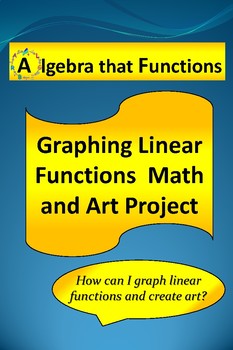Math Project Graphing Linear Functions Math and Art Project *DISTANCE LEARNING
- PDF
- Easel Activity
Description
PRINT and DIGITAL * * Makes distance planning so much easier!
Graphing Linear Equations Math and Art Project
Your students will apply their skills of graphing linear equations with art! Students will graph specified types of linear equations and choose how they create an original piece of art. My students love this project because it provides an opportunity for them to be creative in math class!
This project is a great formative assessment because it assesses students’ skills and is highly engaging! My students are so proud of the art they create! I created two forms of this project. The second form is more challenging than the first form. This allows you to differentiate based on your students’ needs.
TPT buyers said, "Loved the freedom it gave students to express themselves but use Algebra!", "This project was really fun because they got to be creative and everyone had a different picture. They liked seeing them hanging in the hall.", "This was a really fun wrap-up activity after learning all about linear functions", "love this". "Great!" "My students were excited about this project because it was different than book work. They were able to be creative and apply math skills that they've learned over the past month."
I included a rubric and a peer evaluation, which requires students to further apply their skills of linear of equations as they verify that the equations do model the graphs of the lines.
This product is a paid digital download from my TpT store
Algebra that Functions and it is for use in one classroom only. This product is also bound by copyright laws. Redistributing, editing, selling, or posting this item (or any part thereof) on the Internet are all strictly prohibited without first gaining permission from the author. Violations are subject to the penalties of the Digital Millennium Copyright Act. Please contact me if you wish to be granted special permissions!
*Math Project
*Graphing Linear Equations
*Art
*Rubric
*Peer Evaluation
This is a Great Companion to My
Jokes to Start Class Set 1 Laugh in Class!
Jokes to Start Class Set 2 Laugh in Class!
Math Jokes to Start Class Set 1 Laugh in Math!
Math Jokes to Start Class Set 2 Laugh in Math!
Linear Functions: Slope Lesson, Vocab., Guided Notes, Practice, More!
Linear Functions: Graphing Functions Lesson, Vocab., Guided Notes, Practice, More!
Linear Functions: Graphing Linear Funct. Lesson, Vocab., Guided Notes, Practice, More!
Linear Functions: Standard Form, x- and y-intercepts Les., Vocab., Practice, More!
Linear Functions: Point-slope to Slope-intercept Form Les., Vocab., Pract., More!
Slope-intercept and Standard Form Match
Slope and Point to Write Slope-intercept Form Match
Point-slope Form and Slope-intercept Form Match
Linear Functions Formative Assessments Collection
Linear Functions to use as Warm-ups or Formative Assessments or Exit Tickets!
Functions and Linear Functions Task Cards
Linear Functions Exploring How "m" and "b" affect the Graph of the Line
Writing Linear Equations for Word Problems Related to Teens!
Parallel and Perpendicular Equations Match
Finding Slope from a Graph Practice and Review
Graphing Linear Equations Written in Slope-intercept form Practice
Graphing Linear Equations Written in Slope-intercept and Standard form Practice
Graphing Linear Equations Practice and Review
Writing Linear Equations Practice and Review
Graphing Linear Equations using slope and x- and y-intercepts Practice
Linear Functions Writing Equations Using Linear Models
Writing Linear Equations in Slope-intercept, Point-slope, and Standard Form
Linear Functions Writing Equations from Tables
Linear Functions Finding Slope, y-intercept, and Equation from a Graph
Linear Functions Practice Slope formula, Point-slope form, Slope-intercept form
Exploring how m and b Affect the Graph of a Linear Function
Writing Linear Equations in Function Notation for Real-World Situations
MATH PROJECTS!
Math Scatter Plot Project: Are You Really Going to Eat That?
Math Project Equations Writing and Solving in a Fun, Real-World Situation
Math and Art Project Graphing Linear Functions
Math Project Functions Real-World Application Math Project
Math Project Linear Functions Open-Ended Real-World Application
Math Project Linear Functions Summer Jobs
Math and Art Project Graphing Systems of Linear Equations
Math Project Systems of Linear Equations Real-World Open-Ended Project
Math Project Linear Functions and/or Systems of Linear Functions Real-World Application
Math Project Systems of Linear Equations Real-World Sales Representative
Math Project Teens Shopping for Clothes on a Budget
Math Project Graphing Quadratic Functions Math and Art Project
Math Project Quadratic Functions Real-World Application
Math Project Linear and Exponential Functions Which Salary
Math Project Linear, Quadratic, and Exponential Functions Models
Math Project Volume of Cylinders, Cones, and Spheres Real-World Project
Math Project Aquarium Designer Volume of Cylinders, Cones, and Spheres
You Might Also Like
Identifying Critical Information
Rational and Irrational Numbers: Classifying Numbers into Sets
Exponent Properties: Exploring and Applying Properties of Exponents
Order of Operations: Exponents, Roots, Absolute Value
End of Year Project Quadratic Functions
End of Year Math and Art Project Graphing Systems of Equations
Real-World Application of Systems of Equations for Problems Related to Teens!
End of Year Math Project Real-World Application of Systems of Equations
You Might Also Like Exploring Systems of Equations Cell Phone Plans
Beginning of Year Activity Math Bio Poems
Beginning of Year Activity Find Someone Like You!
Customer Tip!
You can get TPT credit to use on future purchases!
Go to your My Purchases page (you need to login). Beside each purchase you'll see a Provide Feedback button. Simply click it and you will be taken to a page where you can give a quick rating and leave a short comment for the product.
Each time you give feedback, TPT gives you feedback credits that you use to lower the cost of your future purchases.
Be the first to know about my sales, freebies and product launches! CLICK ON THE GREEN STAR next to my store logo to become a follower. You will receive updates about my store.




